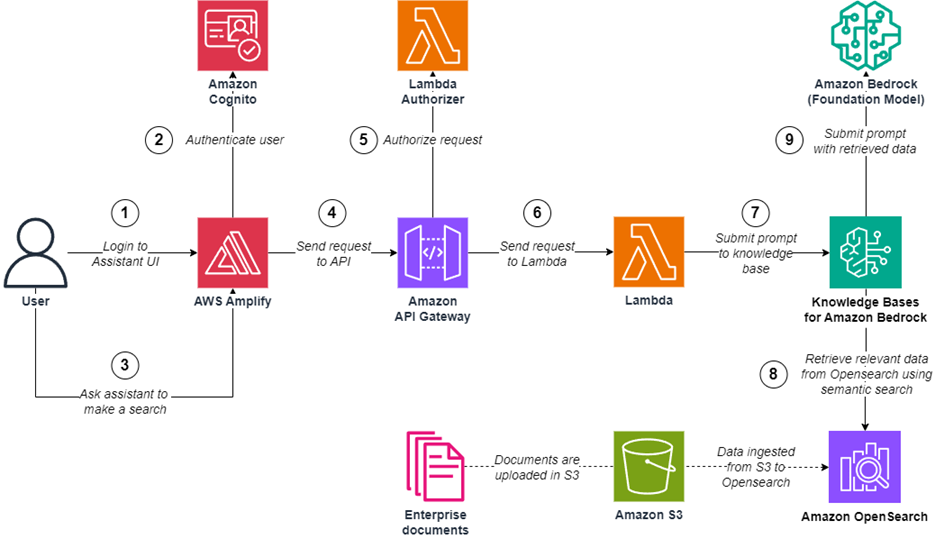Artificial Intelligence
Category: Intermediate (200)
Introducing guardrails in Amazon Bedrock Knowledge Bases
Amazon Bedrock Knowledge Bases is a fully managed capability that helps you securely connect foundation models (FMs) in Amazon Bedrock to your company data using Retrieval Augmented Generation (RAG). This feature streamlines the entire RAG workflow, from ingestion to retrieval and prompt augmentation, eliminating the need for custom data source integrations and data flow management. […]
Access control for vector stores using metadata filtering with Amazon Bedrock Knowledge Bases
In November 2023, we announced Amazon Bedrock Knowledge Bases as generally available. Knowledge bases allow Amazon Bedrock users to unlock the full potential of Retrieval Augmented Generation (RAG) by seamlessly integrating their company data into the language model’s generation process. This feature allows organizations to harness the power of large language models (LLMs) while making […]
Create an end-to-end serverless digital assistant for semantic search with Amazon Bedrock
With the rise of generative artificial intelligence (AI), an increasing number of organizations use digital assistants to have their end-users ask domain-specific questions, using Retrieval Augmented Generation (RAG) over their enterprise data sources. As organizations transition from proofs of concept to production workloads, they establish objectives to run and scale their workloads with minimal operational […]
Indian language RAG with Cohere multilingual embeddings and Anthropic Claude 3 on Amazon Bedrock
Media and entertainment companies serve multilingual audiences with a wide range of content catering to diverse audience segments. These enterprises have access to massive amounts of data collected over their many years of operations. Much of this data is unstructured text and images. Conventional approaches to analyzing unstructured data for generating new content rely on […]
Build an automated insight extraction framework for customer feedback analysis with Amazon Bedrock and Amazon QuickSight
In this post, we explore how to integrate LLMs into enterprise applications to harness their generative capabilities. We delve into the technical aspects of workflow implementation and provide code samples that you can quickly deploy or modify to suit your specific requirements. Whether you’re a developer seeking to incorporate LLMs into your existing systems or a business owner looking to take advantage of the power of NLP, this post can serve as a quick jumpstart.
Build safe and responsible generative AI applications with guardrails
Large language models (LLMs) enable remarkably human-like conversations, allowing builders to create novel applications. LLMs find use in chatbots for customer service, virtual assistants, content generation, and much more. However, the implementation of LLMs without proper caution can lead to the dissemination of misinformation, manipulation of individuals, and the generation of undesirable outputs such as […]
Improve visibility into Amazon Bedrock usage and performance with Amazon CloudWatch
In this blog post, we will share some of capabilities to help you get quick and easy visibility into Amazon Bedrock workloads in context of your broader application. We will use the contextual conversational assistant example in the Amazon Bedrock GitHub repository to provide examples of how you can customize these views to further enhance visibility, tailored to your use case. Specifically, we will describe how you can use the new automatic dashboard in Amazon CloudWatch to get a single pane of glass visibility into the usage and performance of Amazon Bedrock models and gain end-to-end visibility by customizing dashboards with widgets that provide visibility and insights into components and operations such as Retrieval Augmented Generation in your application.
Use zero-shot large language models on Amazon Bedrock for custom named entity recognition
Name entity recognition (NER) is the process of extracting information of interest, called entities, from structured or unstructured text. Manually identifying all mentions of specific types of information in documents is extremely time-consuming and labor-intensive. Some examples include extracting players and positions in an NFL game summary, products mentioned in an AWS keynote transcript, or […]
Safeguard a generative AI travel agent with prompt engineering and Amazon Bedrock Guardrails
In this post, we explore a comprehensive solution for addressing the challenges of securing a virtual travel agent powered by generative AI. We provide an end-to-end example and its accompanying code to demonstrate how to implement prompt engineering techniques, content moderation, and various guardrails to make sure the assistant operates within predefined boundaries by relying on Amazon Bedrock Guardrails. Additionally, we delve into monitoring strategies to track the activation of these safeguards, enabling proactive identification and mitigation of potential issues.
Accelerate deep learning training and simplify orchestration with AWS Trainium and AWS Batch
In large language model (LLM) training, effective orchestration and compute resource management poses a significant challenge. Automation of resource provisioning, scaling, and workflow management is vital for optimizing resource usage and streamlining complex workflows, thereby achieving efficient deep learning training processes. Simplified orchestration enables researchers and practitioners to focus more on model experimentation, hyperparameter tuning, […]









